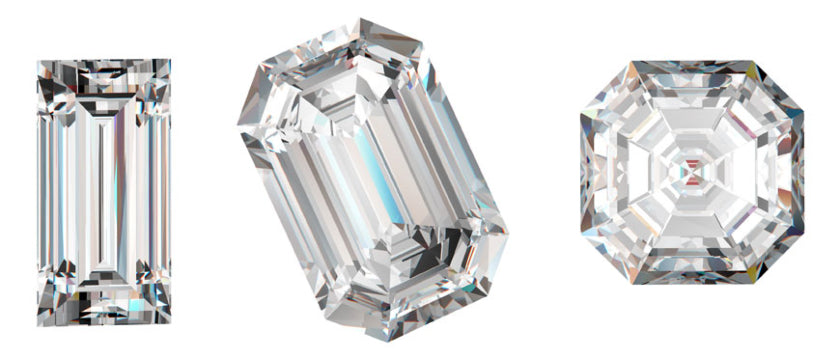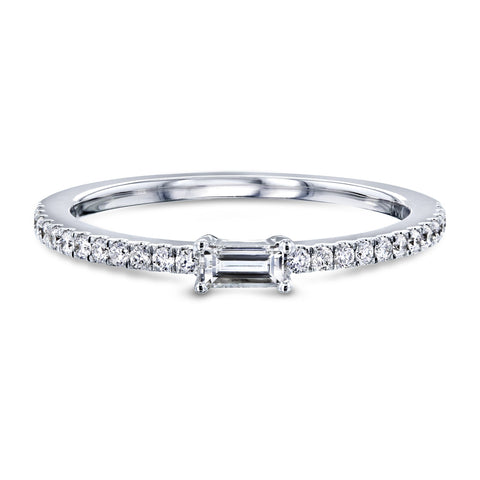What Are Step Cut Diamonds?

To have a dirty, rough diamond transformed into a shiny, faceted stone that takes the breath away with every single look at it, is the most exciting and delightful jewelry-making experience. Hence, the reason why cutting is rather seen as art than just a plain procedure in which a diamond is given its final look. Luckily, today we have at our disposal a multitude of diamond shapes to choose from, each offering a unique representation of “beauty” and “elegance”. In this article, you will learn some interesting facts about step cut diamonds and their importance in the fine jewelry world.
THE DEFINITION
Step cut diamonds have either a square or rectangular shape and they can be easily distinguished from brilliant cut diamonds. Their most remarkable feature are the large diamond facets arranged in a parallel-to-the-girdle fashion. This specific arrangement makes them look like the steps of a pyramid, hence, the name. A diamond that is given a precisely-cut “step” look exhibits the spectacular “hall of mirrors” effect, by also surpassing all expectations in terms of clarity and attractiveness.
Apart from striking brilliance, the second-best attribute of step-faceted stones is carat preservation. In other words, they retain more of the diamond’s material, which is not always the case with other cuts, such as the round brilliant diamond, for example. In addition to this, it is important to mention that step cuts make a diamond appear larger, which is especially beneficial for stones featuring a carat weight of one carat or less.
Some of the most renowned step cut diamonds are:
» emerald
» baguette
» asscher
In the lines that follow, we are going to describe each of them respectively.
EMERALD CUT
Diamonds that are given the emerald shape have cropped corners - the other signature characteristic in addition to the large table and culet facets. They also have a protective function, by making the diamond less vulnerable to chipping and breaking. The top priority of the square emerald cut is to enhance the brilliance and clarity of the stone. Therefore, emerald-cut diamonds do not have as high color grades as other step cut diamonds, like the asscher cut, for example. A typical emerald-cut diamond has 58 facets (25 on the pavilion, 8 on the girdle and 25 on the crown). It usually takes the central position of the piece and it appears equally attractive in solitaire and halo settings.
The only inconvenience about emerald-cut diamonds is that if the stone has some internal flaws, they will be more exposed, which does not necessarily mean that they are going to be visible to the naked eye. In terms of beauty, these diamonds have their very best performance when nestled in metallic, silver-like settings, including white gold, platinum, cobalt and silver itself. The emerald look is most likely to be seen in multi-stone ring designs, especially in three-stone and five-stone diamond engagement rings. Solitaire designs cannot be excluded as well, because an emerald-cut diamond is large enough to reach the desired degree of opulence.
BAGUETTE CUT
“Baguette” is an incredibly attractive diamond shape, hence the reason why it does not fall behind the popularity of the best-selling rectangular cuts. The nature of baguette diamonds is very similar to the nature of emerald diamonds, with the only difference that baguettes have fewer facets (14) and they are slightly longer than the facets of emerald-cut diamonds. In the common jewelry-making practice, baguette diamonds are rarely used alone; they are usually given the role of side stones, with the goal to enhance the presence of the center stone. They can be combined with other diamond shapes to create a more captivating visual effect.
The baguette look promotes thin, step cut diamonds which are desired for many ring styles, although they have proven to appear stunningly beautiful in eternity designs in particular. The name of the cut is derived from the French word “baguette”, which indicates a thin, long shape similar to the shape of the traditional French bread. The brilliance provided by a baguette-cut diamond cannot be compared with the brilliance of the round brilliant stone, but good to know is that baguettes are way more affordable than many other diamond cuts, including the emerald cut itself.
ASSCHER CUT
Asscher is often described as modified emerald cut with square shape and extra depth. Hence, when the diamond sculpted in asscher cut is viewed face down, it displays a series of squares that create a concentric “X” pattern. The asscher cut comes in two versions; the older one was developed in 1902 and it features 58 facets; the newer version is called “The Royal Asscher Cut” and it features 74 facets, which makes it being included in the category of “octagonal step cuts”, due to the cropped corners that give the stone a graceful square silhouette.
The asscher-cut diamond can be easily identified by its small table, high crown and large, step facets that make it a unique shopping option when it comes to step cut diamonds. Asschers are extremely favored for their spectacular luster that reaches the highest grades in comparison with the other two representatives of the “step cut diamonds” category – the emerald and the baguette cut. The asscher look is also part of the signature jewelry of the royalty, for which it is immensely treasured in the fine jewelry world.
Want to learn more? Read on to find out how the savvy customer shops for step cut diamonds.
☞ He/She considers vintage jewelry designs.
An emerald, baguette or asscher diamond makes an excellent alternative for vintage-inspired jewelry, which is exactly where their widespread popularity comes from. Beyond a shadow of doubt, any of these stones will give the wearer an authentic look that will stand for both generosity and confidence. If you are not sure if step cut diamond jewelry is modish or old fashioned, let me tell you that some of world’s biggest celebrities, like Angelina Jolie, Beyoncé and Amal Clooney love wearing it, especially on the red carpet.
☞ He/She concentrates on the two most important features – CLARITY and CUT.
The diamond’s clarity performance is what makes step cuts valuable or not. Since these diamonds have large facets, it is much easier to notice the blemishes or inclusions (if any). Hence, the savvy consumer invests in a step cut diamond with higher clarity grade of at least VVS2. That is how you will get the most sparkle and at the same time, you can enjoy in an inclusion-free precious stone. The cut, on the other hand, refers to the symmetry and polish of the diamond, which can be graded altogether as “excellent”, “very good”, “good”, “fair” and “poor”. A “very good” and “good” cut grade is fairly enough for a quality and reasonable diamond purchase.
☞ His/Her top priorities are AFFORDABILITY and ATTRACTIVENESS.
Step cut diamonds may not be as celebrated as round, cushion and princess stones, but they come at significantly lower prices, which is one of the major reasons why customers go after them. Therefore, an engagement ring that is centrally mounted with a 1-carat cushion diamond will cost a few hundred dollars more or maybe a thousand than a 1-carat emerald jewel, which can be found for as low as £1,327.00. Last but not least, step cut diamonds have the power to turn heads wherever they appear, regardless of the time or occasion. It is just in their essence, to be a mesmerizing motif of a woman’s natural beauty.















